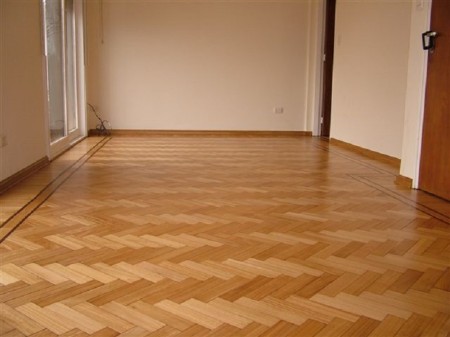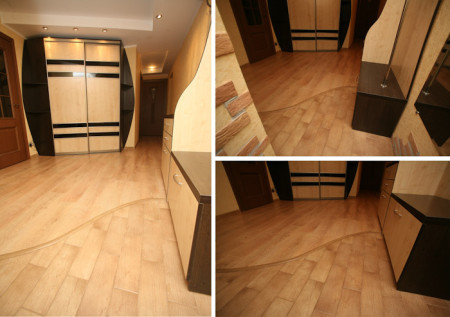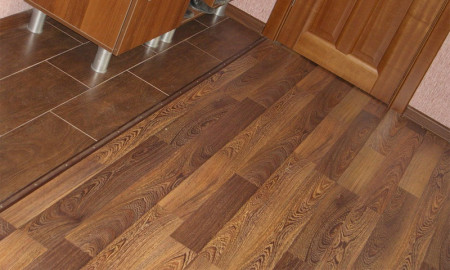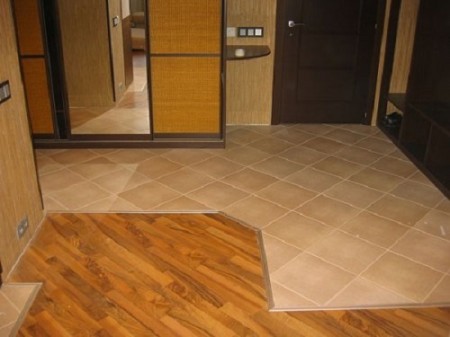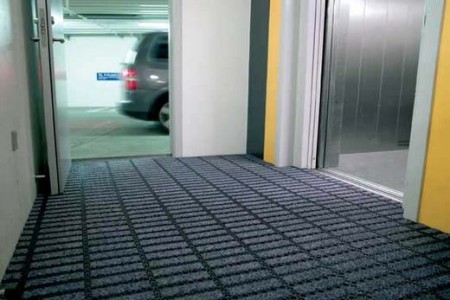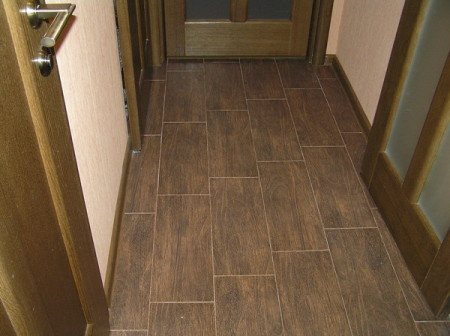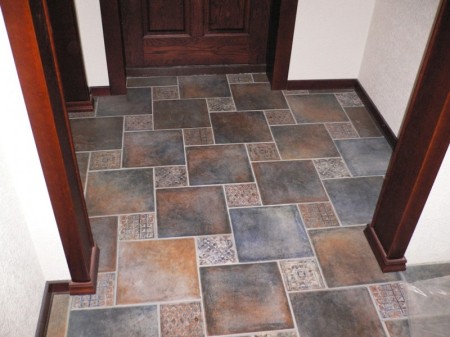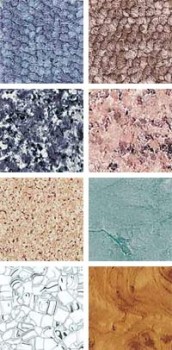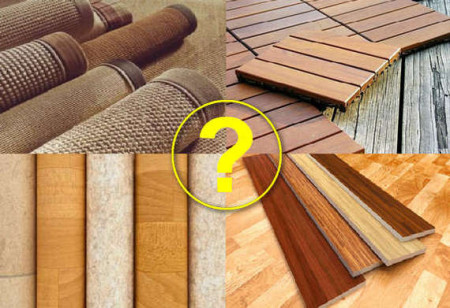Quite often the owners of an apartment or a country house have a question: what material is better to use as a flooring for the hallway? At first glance, ceramic tile or linoleum is the best for this purpose - strong, unpretentious in maintenance and relatively durable materials. However, today there is such a variety of floor coverings, which are used in the hallways, that this issue deserves more detailed consideration.
Content
Types of floor coverings
So, today the choice is quite wide: linoleum of all kinds, tile, carpet, granite, laminate, mats, etc.
Consider the most popular materials in more detail:
piece parquet
Natural piece parquet in the hall - all known material, is a floor covering made of natural wooden blocks (slats). After laying the finished parquet is often opened with several layers of varnish. Less often - waxing. With proper care, parquet can last for decades.
The entrance hall of 10 squares, laid with a parquet floor, "flies" to the owners (with all the works on a turn-key basis) of not less than 1000 dollars.
parquet board in the hallway
As in the rest of the rooms is a solid coating of natural board. Individual elements of such a coating are called lamellas. Usually the length of the lamella is about 2 to 2.5 m. The width is about 20 cm, the height is 14-25 mm. The lamella consists of several layers, like a sandwich: the first, the top layer is made of good veneer valuable hardwoods, the two lower layers are bars from inexpensive coniferous species. The varnish coating from the manufacturer of such a parquet can last for about 15 years.
Parquet board has several important advantages: it is not very difficult to work with, and its laying does not require a perfectly flat "rough" floor. Thanks to these moments, the floor in the hallway will cost about two times cheaper than the stowed parquet floor - about $ 500.
An important point: both piece parquet and parquet board require careful care, it is unacceptable to constantly walk on it in dirty shoes, move the furniture over the surface - from such treatment on the varnish coating "gaps" will quickly appear. In addition, when cleaning the parquet floor, you can not use aggressive chemicals.
laminate in the hallway
Sufficiently good material in terms of resistance to abrasion and mechanical damage. The weak point of any laminate is its joints, through which moisture easily penetrates down and can damage the material. And since wet shoes in the hallway - a frequent phenomenon, it is worth paying attention to the special composition for moisture-proof grouting on the laminate - "Bonakire", produced by the Swedes, or rather - the firm "Bona". When using this product, it must be remembered that it contains oily substances, so the floor surface after working with the "Bonaiker" needs to be thoroughly wiped. It should be noted that expensive grades of laminate are already impregnated with moisture-resistant compounds, however such material is at the cost of a good oak board. So it's worth thinking about - maybe it's better to buy natural parquet? However, this is the personal preference of everyone.
Laminate - a multi-layer material, the base of which is made of compacted fiberboard. Top - a layer of paper with a pattern, on which a transparent protective layer is applied. Laminate has different levels of durability - 21, 22, 23 class - for "home" or household laminate, 31, 32, 33 class - for "commercial material. The cheapest laminate is, on average, 5 years, the most expensive - up to 10 years. There are also separate types of laminate, the shelf life of which is more than 10 years.
An interesting option is the so-called "dedicated hallway". In this case, the territory where the guests wear / remove their shoes is finished with a durable, wear-resistant material, such as a natural stone or a good ceramic tile.
Further on the same level, any material is laid: a board, a parquet, a laminate, etc. The seam between the wood and the tile must be protected with inserts made of soft plastic or cork - the material will compensate for the loads from the natural deformation of the wood.
The floor in the hallway of 10 squares will cost from 13 to 26 dollars per square meter.
In addition to the laminate itself, you will also need a special substrate (from $ 1 per square), a plinth (from $ 2 per meter), glue (for glue laminate) - from $ 5 per package.
carpeting or carpeting
Carpet is a roll material, it can be artificial and natural. The natural material is made from a mixture of wool and fibers of vegetable origin. Such a carpet is made on the basis of natural jute.
Artificial carpet is made of synthetics: polyamide (nylon), acrylic, polyester, etc. This material has a base of synthetic jute, and can last up to 15 years.
For the hallway, natural carpet is not suitable - it absorbs moisture, which will spoil the coating from below. If you decide to still lay the carpet in the hallway, it is better to choose the artificial material.
How much does it cost: an artificial carpet will cost from 7 to 13 dollars per square. Special substrate - from 5 dollars.
linoleum for the hallway
Artificial linoleum - a multilayered material from PVC. Its service life depends on the thickness of the top working layer, which should be from 0.15 to 0.7 mm. Depending on this indicator, all types of linoleum are divided into household (intended for residential premises with a service life of up to 10 years), and public (service life up to 25 years).
Traditionally, this is the most common and common material in our hallways. However, this linoleum is a mixture of wood flour, linseed oil, cork and chalk. This linoleum serves without any problems for decades, it is absolutely not afraid of dirt, water and mechanical damage. One significant drawback - a poor choice of colors and patterns, except for this linoleum need from time to time to rub with special mastic. Such material would be a truly ideal material for the hallway, but it is sold only under the order in large quantities. For this reason, in the building materials stores only the so-called "artificial linoleum" is sold and, more precisely, PVC-coating for the floor.
To distinguish household linoleum from commercial is quite simple - household very easily bends, costs from 5 to 9 dollars per square meter. Commercial material is a solid, uniform coating, the pattern on which is preserved until the linoleum is completely abraded. There is such material from 7 to 30 dollars per square meter.
Thus, it becomes clear which linoleum in the hallway it is better to lay - for this purpose the commercial option is definitely better, although it is much more expensive.
There is a good linoleum from 10 dollars per square. Glue with a double-sided adhesive tape (about two rolls - about 6 dollars).
ceramic tile or porcelain tiles
To a ceramic tile carry the big group of coverings of the different size, the form and a kind. They are all made from molded clay. Ceramic tiles are wall and floor. They can not be confused: the wall - on the wall, the floor - on the floor, because these two types have different characteristics.
Ceramic granite is called a plate of different sizes, made of the same clay, but in appearance resemble a natural stone. This material is well resistant to frost, it is very dense, resistant to chemicals, has good water-repellent properties. If the porcelain is of high quality, it has a density of not less than 18 kg / sq. M. Can be polished, unpolished, with a relief surface (anti-slip), and also matt.
High-quality ceramic tiles serve very long. It is for this reason that for professionals with a very intense human flow, professionals recommend ceramic tiles as flooring. In addition to the fact that ceramic tiles are extremely strong and durable material, the choice of this material is extremely wide. You can buy matte tiles, under the stone, in the range there are many additional elements - all kinds of inserts, borders, etc. The sale also has a special relief floor tile, which you can safely walk even in wet shoes. There is also a special anti-slip floor tile with corundum spraying, which can be laid on uneven surfaces, for example, on ramps. However, for all its numerous advantages, ceramic tiles are a cold material.
The average cost of floor tiles of acceptable quality is about $ 20 per square meter. The material of domestic production is somewhat cheaper - about $ 10 per square.
Other types of floor coverings
Among other alternative versions of flooring for the hallway, I would like to highlight a very exotic material, so far not so widespread in our country - the so-called golden tile. By the way, it is produced exclusively by South Korea.
This floor covering is a plate made of crumbs of natural stone and special polymers. The tile consists of six layers. The lowest, so-called balancing layer is made of dense PVC. The basis of the tile is a crushed natural stone mixed with natural resins. The inner core layer is a special kind of fiberglass. The penultimate transparent layer (wear layer), and the last, the uppermost - protection from ultraviolet rays.
Gold tiles can be stacked in any room - both residential and public. The period of its use can reach 20 or more years. The tile is not afraid of fire, water, household chemicals, it does not skip, it does not slip, it is very easy to wash with ordinary household means.
Koreans quite interestingly determine the degree of wear resistance of tiles - the number of steps that need to be taken before the appearance of the first symptoms of wear of the material. This, for a minute, about ten million steps. Speaking figuratively, an ordinary family of four people, without stopping to walk on the tile around the clock for 10 years, to work out such a number of steps. In addition, the gold tile is one of the most environmentally friendly floor coverings.
How much will this pleasure cost? Let's take an area of 10 square meters. The tile itself costs from $ 17 per square, plus a special glue - from $ 13 per pack (sold in the same place as the tile). Packing glue is enough to lay 6 squares. Total - for 10 square meters will have to buy two packs of glue - $ 26 minimum. The tiles are 170 + 26 + 70 (about as much for leveling the floor) = 266 dollars for 10 squares of the hallway.
Expert opinion, what to choose for the hallway
So, what conclusion can be drawn from all of the above? All floor coverings mentioned in this publication can be used for finishing the floor in the hallway. However, artificial material (especially linoleum) can cause allergy, it must be taken into account.
Of course, each buyer is guided by personal preferences, needs and financial capabilities. Nevertheless, when going to buy material for the floor in the hallway, remember:
For this purpose are well suited:
• Laminate (class of wear resistance not lower than 31 - prefabricated and water resistant versions).
• Artificial carpeting (high density, with nylon thread, tufted or needle-punched).
• Ceramic tiles (embossed or matt, with increased durability).
• Gold Korean tiles.
Gold and ceramic tiles are the only materials whose service life is more than 10 years. All other materials listed above serve up to 10 years or less. This also needs to be taken into account when choosing.



